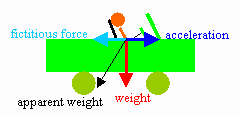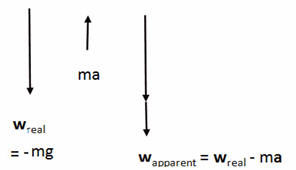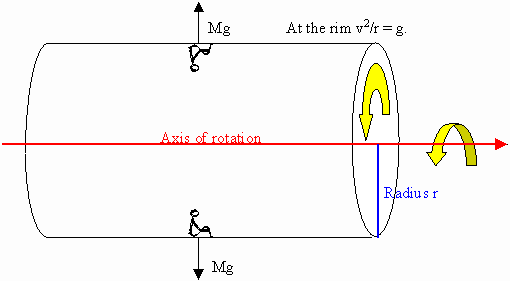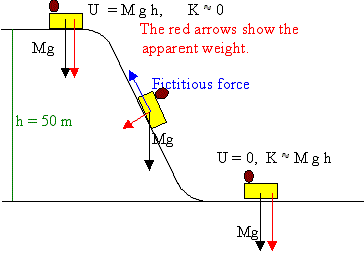Fictitious Forces
Newton's first law, also called the law of inertia,
defines a special class of reference frames, called inertial frames.
It states that, when viewed in an inertial reference frame, an object at rest
remains at rest and an object in motion continues in motion with constant
velocity unless it is acted on by an external net force. Newton's second law
and Newton's third law correctly describe the motion of objects as viewed
by observers in inertial reference frames. In an inertial frame
F = ma, where the net force
F is the vector sum of all the
real known forces acting on an object of mass m.
If observers at rest in an accelerating frame want to use F = ma
to predict the motion of an objet in their reference frame, then
F has to
include not only the vector sum of all the real known forces acting on the
object but also a fictitious force. Fictitious forces appear in
accelerating frames.
 You just got your new car. You want to experience it. You want to "feel"
its power. You floor the gas pedal, and you experience a force pressing you
back into your seat. Where does this force come from?
You just got your new car. You want to experience it. You want to "feel"
its power. You floor the gas pedal, and you experience a force pressing you
back into your seat. Where does this force come from?
This
force is a fictitious force. Fictitious forces appear in accelerating
reference frames. Such frames are NOT inertial reference frames. The
accelerating reference frame in the above example is accelerating with your car.
In this frame your car and you are at rest. But you are feeling a force
pushing you against the back of your seat. To your friend observing you
from the sidewalk things look different. The motor is responsible for the
forward acceleration of the car. Because of your mass, you have inertia.
Without a force acting on you, you would remain at rest with respect to the
sidewalk. To keep you accelerating forward, the back of the seat has
to push on you. (You will be pushing on the seat with a force equal in
magnitude, but opposite in direction.) The fictitious force appearing in
the accelerating frame is the negative of the real force responsible for maintaining your acceleration and
keeping you at rest in the accelerating frame. The real force acting on you is
in the forward direction, while the fictitious force experienced in the
accelerating frame is in the backward direction.
In the accelerating frame of the car, you experience
the fictitious force in the backward direction and your weight, pointing
down. The net force experienced is the vector sum of these two forces.
This force becomes your apparent weight,
which points in a direction backward and down.
The apparent weight of
an accelerating object is the vector sum of its real weight and
the negative of all the forces that produce the object's acceleration
a = dv/dt.
wapparent =
wreal - ma.
 When
you stand on a bathroom scale in an inertial frame, such as in your bathroom,
the scale reading is proportional to your real weight. When you stand on a
bathroom scale in an accelerating frame, such as an elevator
accelerating upward, its reading is proportional to your apparent weight.
When
you stand on a bathroom scale in an inertial frame, such as in your bathroom,
the scale reading is proportional to your real weight. When you stand on a
bathroom scale in an accelerating frame, such as an elevator
accelerating upward, its reading is proportional to your apparent weight.
For the elevator accelerating upward:

In every accelerating frame we have wapparent =
wreal - ma. The apparent weight of a mass m is
its real weight minus its mass times the acceleration of the frame (vector
addition).
Assume you are riding on a merry-go-round. A reference frame in which you
are stationary, i.e. a frame that is moving with you as you are moving along a
circular path, is also an accelerating frame. This frame is moving with
constant speed, but the direction of its velocity is constantly changing. You
are sitting still on your seat while the merry-go-round is turning. But
something seems to be pulling you towards the outside, away from the center.
You experience a fictitious force. To your friend on the ground things again
look different. You are moving in a circle. The direction of your velocity is
constantly changing. You are accelerating. The direction of your acceleration
is towards the center of the circle, so there must be a force pushing or pulling
you toward the center. If you are sitting in a seat, the wall of the seat will
be pushing against you, pushing you towards the center.
As an object moves along a circular path, the direction of its velocity is constantly
changing. The direction of the acceleration is towards the center of the circle.
The
magnitude of the acceleration, v2/r, depends on the speed and the radius of the
circle along which the object traveling. In an accelerating frame, which is moving with
the object, the object is at rest. But it experiences the fictitious centrifugal force,
constantly trying to throw it towards the outside of the circle.
In outer space, where wreal is approximately zero, wapparent
= -ma. In many Science Fiction books, humans live in space in a space station that
is rotating about a central axis. Their real weight is close to zero. The
acceleration of a person with mass M at rest with respect to the space station
near the rim is a = v2/r directed towards the axis. The
apparent weight of the person is wapparent =
wreal
- Ma = Mv2/r directed towards the rim.
If the rim is the floor of some room without windows, and the rotation speed and
the radius of the station are adjusted so that a = v2/r = g, then
there is no way a human or a scientific instrument in the room can distinguish
between the apparent weight and the force of gravity. If the human steps on a
scale, the scale will read the same "weight" as it does on the surface on
earth. If the human throws a ball near the "surface", the ball will follow the
same trajectory it would on earth.

Problem:
Engineers are trying to create artificial gravity in a ring-shaped space
station by spinning it like a centrifuge. The ring is 100 m in radius. How
quickly must the space station turn in order to give the astronauts inside it
apparent weights equal to their real weights at the earth's surface
Solution:
- Reasoning:
We want a = v2/r = g , or v2 = gr.
- Details of the calculation:
v2 = gr = (9.8 m/s2)(100
m) = 980 (m/s)2. Therefore v = 31.3 m/s.
The circumference of the space station is 2πr = 628 m.
The space station therefore must completes a turn in (628 m)/(31.3 m/s) = 20 s.
Roller Coasters
 In an amusement park the most thrilling rides let the rider experience the largest
fictitious forces. Fictitious forces are experienced in accelerating reference frames.
The
seat or cart in which the rider is sitting is accelerating, because it is speeding up,
slowing down, or turning rapidly. A ride that is just moving you along with constant
velocity will probably not excite you. You might as well be in your car on the freeway
with the cruise control engaged.
In an amusement park the most thrilling rides let the rider experience the largest
fictitious forces. Fictitious forces are experienced in accelerating reference frames.
The
seat or cart in which the rider is sitting is accelerating, because it is speeding up,
slowing down, or turning rapidly. A ride that is just moving you along with constant
velocity will probably not excite you. You might as well be in your car on the freeway
with the cruise control engaged.
Roller coasters offer thrilling rides. Most roller coaster rides start with a steep
"vertical" drop. The cart descends on a track down a very steep slope.
Assume the top of the hill is 50 m above the ground. The gravitational potential energy
of a object on top of the hill is Mgh. Neglecting friction, this potential energy has been
converted into kinetic energy when the object reaches the bottom of the hill.
K = ½Mv2= Mgh.
v2 = 2gh = 2*(9.8 m/s2)*(50 m)
= 980 (m/s)2.
v = 31.1 m/s = 70 mph.
At the bottom of the hill the object (the cart, you, …) moves with a speed of 70 mph.
The forces on the object as it descends are the force of gravity and the support from
the track. The component of the gravitational force perpendicular to the track is canceled
by the support from the track, and the component of the gravitational force tangential to
the track accelerate the object. However if you are sitting in the accelerating cart, then
you are experiencing a fictitious force in the direction opposite to the
direction of the velocity in
addition to the other forces. This force cancels the tangential component of gravity.
You
are left with an apparent weight only due to the perpendicular component of the force of
gravity, much less than your normal weight.
if the track pointed straight down, the perpendicular component of the
gravitational force would be zero, and your apparent weight would be zero.
You would feel weightless.
Feeling weightless means that your apparent weight
(not necessarily your real weight) is zero.
A friend on the ground observes you
accelerating with acceleration g because of your real weight. The weight of the cart also
accelerates the cart at 9.8 m/s2. Your velocity and the velocity of the cart
change at the same rate, your relative velocity stays zero. You are both in
free fall, not subject to any forces other than gravity,
just as a skydiver, who stepped out of an airplane.
Since the cart of a roller coaster is attached to a track, it is possible, using
motors, to produce accelerations in the direction of the velocity greater than g.
 Many roller coasters have a vertical loop, 20 m high. Assume a cart enters the loop at
a speed of 25 m/s or 56 mph. As the cart moves through the loop, it is moving in a circle
and therefore it is accelerating. An observer on the ground concludes that the forces on
the cart are the force of gravity and the support from the track. The support from the
track has to cancel the component of the weight perpendicular to the track.
But if it just
did that, the cart would keep on moving tangential to the track, since there would be no
force pointing towards the center of the circle, providing the centripetal acceleration.
So the force that the track exerts on the cart must be the sum of the perpendicular
component of mg and the centripetal force mv2/r.
Many roller coasters have a vertical loop, 20 m high. Assume a cart enters the loop at
a speed of 25 m/s or 56 mph. As the cart moves through the loop, it is moving in a circle
and therefore it is accelerating. An observer on the ground concludes that the forces on
the cart are the force of gravity and the support from the track. The support from the
track has to cancel the component of the weight perpendicular to the track.
But if it just
did that, the cart would keep on moving tangential to the track, since there would be no
force pointing towards the center of the circle, providing the centripetal acceleration.
So the force that the track exerts on the cart must be the sum of the perpendicular
component of mg and the centripetal force mv2/r.
A rider in the accelerating cart again experience a fictitious force in addition to the
real forces. At the bottom of the loop the fictitious centrifugal force has magnitude mass*(25 m/s)2/(10 m) = mass*62.5 m/s2
= mass*6.4 g in the downward direction. This force is added to
the rider's weight to yield an apparent weight of mass*7.4 g.
On the top of the loop the sum of the cart's kinetic energy has been converted into
potential energy.
½mvtop2 = ½mvbottom2 - mgh.
vtop2 = vbottom2
- 2gh = (25 m/s)2
- 2*(9.8 m/s2)*(20 m)
= 233 (m/s)2.
v = 15.3 m/s.
The fictitious centripetal force the rider experience is now directed upward and has
magnitude
mv2/r = mass*(15.3 m/s)2/(10 m)
= mass*(23.4 m/s2)
= mass*2.4 g.
Subtracting the real weight of the rider, which points in the downward direction, we
obtain an apparent weight = mass*1.4 g in the upward direction.
Things seem to "fall" upward, towards the bottom of the inverted car.
Halfway up the loop the weight points straight down, but the fictitious
centrifugal force points horizontally toward the outside of the loop.
The apparent weight is the vector sum of these forces.
Module 5: Question 2
Is there a real force that throws water from clothes during the spin cycle of
a washing machine? Explain how the water is removed.
Discuss this with your fellow students in the discussion forum!
Links:
Roller Coaster
G-Forces
The right-hand turn
 You just got your new car. You want to experience it. You want to "feel"
its power. You floor the gas pedal, and you experience a force pressing you
back into your seat. Where does this force come from?
You just got your new car. You want to experience it. You want to "feel"
its power. You floor the gas pedal, and you experience a force pressing you
back into your seat. Where does this force come from? When
you stand on a bathroom scale in an inertial frame, such as in your bathroom,
the scale reading is proportional to your real weight. When you stand on a
bathroom scale in an accelerating frame, such as an elevator
accelerating upward, its reading is proportional to your apparent weight.
When
you stand on a bathroom scale in an inertial frame, such as in your bathroom,
the scale reading is proportional to your real weight. When you stand on a
bathroom scale in an accelerating frame, such as an elevator
accelerating upward, its reading is proportional to your apparent weight.


 In an amusement park the most thrilling rides let the rider experience the largest
fictitious forces. Fictitious forces are experienced in accelerating reference frames.
The
seat or cart in which the rider is sitting is accelerating, because it is speeding up,
slowing down, or turning rapidly. A ride that is just moving you along with constant
velocity will probably not excite you. You might as well be in your car on the freeway
with the cruise control engaged.
In an amusement park the most thrilling rides let the rider experience the largest
fictitious forces. Fictitious forces are experienced in accelerating reference frames.
The
seat or cart in which the rider is sitting is accelerating, because it is speeding up,
slowing down, or turning rapidly. A ride that is just moving you along with constant
velocity will probably not excite you. You might as well be in your car on the freeway
with the cruise control engaged. Many roller coasters have a vertical loop, 20 m high. Assume a cart enters the loop at
a speed of 25 m/s or 56 mph. As the cart moves through the loop, it is moving in a circle
and therefore it is accelerating. An observer on the ground concludes that the forces on
the cart are the force of gravity and the support from the track. The support from the
track has to cancel the component of the weight perpendicular to the track.
But if it just
did that, the cart would keep on moving tangential to the track, since there would be no
force pointing towards the center of the circle, providing the centripetal acceleration.
So the force that the track exerts on the cart must be the sum of the perpendicular
component of mg and the centripetal force mv2/r.
Many roller coasters have a vertical loop, 20 m high. Assume a cart enters the loop at
a speed of 25 m/s or 56 mph. As the cart moves through the loop, it is moving in a circle
and therefore it is accelerating. An observer on the ground concludes that the forces on
the cart are the force of gravity and the support from the track. The support from the
track has to cancel the component of the weight perpendicular to the track.
But if it just
did that, the cart would keep on moving tangential to the track, since there would be no
force pointing towards the center of the circle, providing the centripetal acceleration.
So the force that the track exerts on the cart must be the sum of the perpendicular
component of mg and the centripetal force mv2/r.